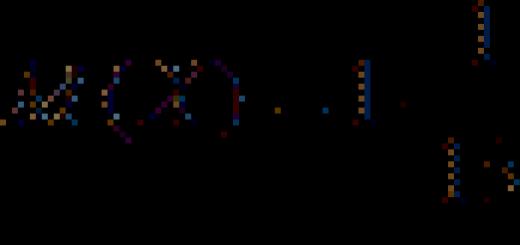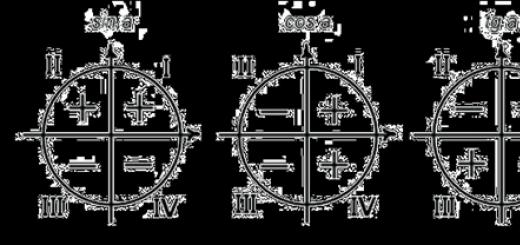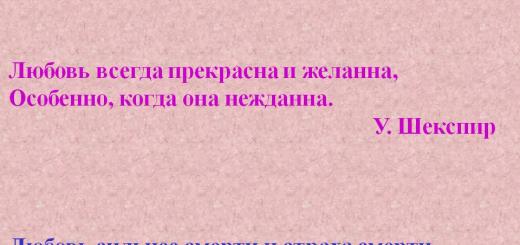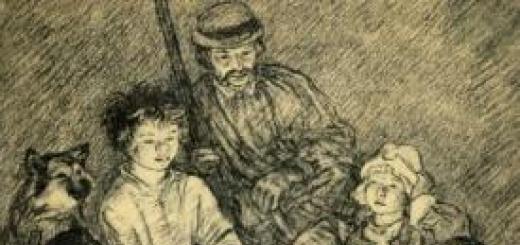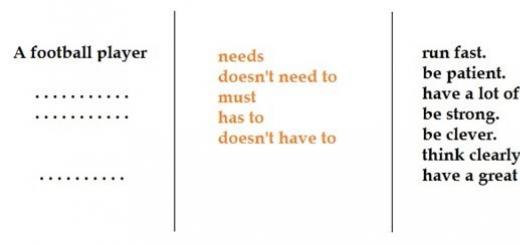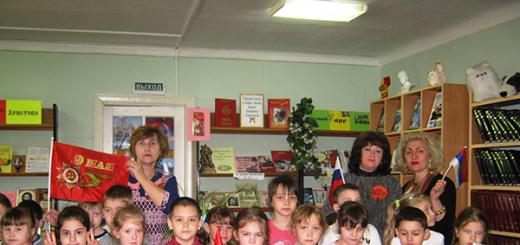Indefinite articlein English it has two forms -a And an. This article comes from the numeralone - oneand therefore is used with singular countable nouns.There is no indefinite article in the plural and is not replaced by another qualifier. Forma[ə]is used before words beginning with a consonant, and the forman [ən]used before words beginning with a vowel sound.
Use of the indefinite article a/an
At the first mention of the subject | A man is waiting for you. A man is waiting for you. (some kind) |
If you can replace the article with the word “one” | A packet of biscuits, please.One pack cookies, Please. |
Any object from a number of similar ones is meant | Give me a ruler! I want to draw a straight line.Give me (any) ruler. I want to draw a straight line. |
With a noun preceded by a descriptive adjective | It was a boring, tedious movie.It was a boring, tedious movie. |
In the nominal part of a compound predicate | He is an engineer. He engineer. She is a student. Shestudent. It's a big city. This is a big city. |
The subject acts as a representative of its entire class | An elephant has got a long trunk.U elephant long trunk. |
In stable combinations like what a.. | What a lovely day! What a beautiful day! |
Before the words such, quite, rather, most (meaning “very”) | He is quite a young man. He is quite a young man. |
Cathedral have something/have got something | I have (got) an orange.U me There is orange . |
Cathedral there is ( there was or there will be ) | There is a subway in New York.There is a subway in New York. Join us onFacebook! |
First of all, thank you so much for your letters and reviews! We are very pleased that our work helps you in learning English! :)
Especially at your request, we have prepared material on the use of the indefinite article A(AN).
What is an article? This is an auxiliary part of speech that is placed before a noun to show the definiteness or uncertainty of the subject. In other words, articles make it clear whether the interlocutors are familiar with the subject or not. The function of articles is to define, therefore the part of speech to which they refer is called Determinants or Determiners.You can learn more about them from this article.
The article A (AN) comes from the numeral ONE (one) and is therefore called indefinite, which does not denote a specific object known to the interlocutors (unlike the), but one of many, some, no matter what, indefinite.
Why does the article A have two forms?
You may know that the AN form is used when the noun after the article begins with a vowel:
An apple, an egg, an elephant
But be careful, because the choice of the article form depends not on the letter (what we see in the letter), but on the sound. For example, take the word university. The first letter u conveys two sounds: . The first one, as you can see [j]. It is a consonant, so the article a should be used before the word univercity. In the same way with the words hour or the adjective honest (in combination honest man). In both words, the first h is unreadable, so we start pronouncing the word with a vowel and use the article AN.
There are quite a few words in English that have silent consonants or diphthongs at the beginning, so when choosing an article, be guided by the pronunciation of the word, not its spelling.
Let's take a look at the main cases in which we use the article A. They are all somewhat similar and complement each other in many ways, but if you understand the basic idea of using the article, you can always use it correctly.
Article A is used in the following cases:
1. If there is only one subject and it is uncertain. To check, you can substitute the following words instead of the article: some, one of many, one of, any
I work in an office. - I work in an office. (I work in some office / in one of the offices).
She bought a car. - She bought (one) car. (She bought one car / some kind of car).
They passed an exam. - They passed (one) exam. (They passed some kind of exam / one of many exams).
I would like a cup of coffee. - I would like (one) cup of coffee. (Not two, one).
2. If an object belongs to a certain class, it is “one of many” representatives of this class. Therefore, A is always used before the names of professions and nationalities:
I am a teacher. - I'm a teacher. (There are many teachers and I am one of them).
She wants to become a student of this university. - She wants to become a student at this university. (There are many students in this university and she wants to become one of them).
He is a Republican. - He is a Republican. (He is one of the Republicans, belongs to this category).
We want to buy a flat in the center. - We want to buy an apartment in the center. (There are many apartments in the center and we want to buy one of them).
3. When we give a definition, we explain what this or that object is. At the same time, we mean that this definition applies to any representative of this category:
A doctor is a person who treats sick people. - A doctor is a person who treats patients. (Any doctor treats patients).
A penguin is a bird that can’t fly. - A penguin is a bird that cannot fly. (Any penguin cannot fly.
A penguin is one of the birds that cannot fly).
A bear is a wild animal. - A bear is a wild animal. (Any bear is a wild animal / one of the wild animals).
You can object and say that not every doctor treats and not every wild bear, but we are looking at special cases, but general ones.
4. In type descriptions: A + adjective + noun to describe an object. In this case, the choice of article A or AN is determined by the first sound of the adjective, not the noun:
This is an orange ball. - This is an orange ball.
He is a clever student. - He is a smart student.
We saw a very tall tree. - We saw a very tall tree.
5. When we talk about using things. Construction: use something as a ... :
He used a stub as a stool. - He used the tree stump as a stool.
She used a napkin as a note. - They used the napkin as a note.
Don’t use your fork as a pointer. - Don't use your fork as a pointer.
6. In negative and interrogative sentences and after the phrase there is with a singular countable noun:
In this case, we know nothing about the object except that it is one of many.
7. Article A is used in measurements:
Once a day - once a day
Twice a week - twice a day
40 km an hour - 40 kilometers per hour
In words denoting one unit of measurement (for example: hundred, thousand, kilogram) A and one can be interchanged:
One hundred = a hundred
One thousand = a thousand
One kilo = a kilo One mile = a mile
8. In exclamations in combination with what, what a lot and such (to emphasize the severity of the attribute):
What a nice day! - What a wonderful day!
What a lot of books! - How many books!
He is such an intelligent person! - He is such a smart man!
9. We use A with paired nouns. Some nouns are considered in pairs, in which case the article a is placed before the first noun:
A knife and fork - knife and fork
A cup and saucer - cup and saucer
There is no need to confuse pairs with single nouns, which simply stand next to each other in a sentence:
I bought a pen and a book. -I bought a pen and a book.
10. With words indicating health problems:
A headache - headache
a cold - a cold
a sore throat - sore throat
a broken arm/leg - broken arm/leg
a weak heart - weak heart
(a) toothache - toothache (can be without the article)
(an) earache - pain in the ear (can be without the article)
11. Lastly, but perhaps most importantly, the indefinite article A is used when we mention something for the first time, when the interlocutor knows nothing about the subject:
I have got a cat. - I have a cat.
He met a beautiful girl. - He met a beautiful girl.
For further references, the definite article the should be used, but more on that in the next article.
Let's summarize the main points: The indefinite article A is used only with countable nouns in the singular, if the subject we are talking about is mentioned for the first time, is indefinite, one of many of its kind, any.
Usually articles are not translated into Russian. However, in rare cases the context requires the translation of the indefinite article into words some, any, one (of), and a certain one - that (same) or this one (the one):
She's murmured a name and the name was not John. - She whispered some name, And this name is was not John.
Let's consider three cases: when an indefinite or definite article is used before a noun, and when it is not used.
Indefinite article
Indefinite article a (an) came from the numeral one (one), so it is used only with singular nouns.
When changing a singular number to a plural, the article is omitted, and if a certain quantity is implied, then a pronoun is put instead of the article some:
Give me a book. - Give me books.
Give me an apple. - Give me some apples.
The indefinite article has a variant A, if it comes before a noun starting with a consonant: a s student; and option an- before a noun starting with a vowel: an a pple.
A noun with an indefinite article represents the name of an object in general, rather than the name of a specific object. For example a student evokes an idea of a student in general, that is, of a student of a higher educational institution, but not of a specific person.
The meaning of the indefinite article can be expressed in Russian with words such as one, one of, some, any, some, every, any, each.
Rules of use
When it is possible to substitute before a noun according to its meaning some kind, any, one of:
There is a pen on the table. — There is a (some undefined) pen (one of the class of pens) on the table.
A child can understand it. - (Any) child can understand this;
When the value is saved one:
Wait a minute! — Wait (one) minute!
The indefinite article is used with singular countable nouns. Not used in the plural, sometimes replaced by indefinite pronouns some (several) any (any, everyone).
If there is a definition before a noun, then the article is placed before this definition: a story(story) an interesting story(interesting story).
Definite article
The definite article has a single form the and comes from the demonstrative pronoun that(That). It is used with nouns, both singular and plural.
Article the pronounced in two ways:
- [ðǝ] before nouns that begin with a consonant: the student[ðǝˊstju:dǝntJ;
- [ðɪ] before nouns that begin with a vowel: the evening[ðɪˊɪ:vnɪη].
The definite article is used:
When in front of a noun you can put this(most) or That(most):
That is the house that Jack built. - This is the house that Jack built.
Before singular nouns:
the sun - the sun;
the moon - the moon.
Before adjectives in the superlative degree:
the cleverest boy - the smartest boy;
the most difficult question - the most difficult question.
No article
The indefinite article is not used: before nouns plural: an article - articles.
Real nouns uncountable: water (water), salt (salt), tea (tea)- nouns that cannot be counted, for example, you cannot say: three waters.
The article is not placed before the noun when it is used in the abstract sense:
Man is the head but woman is the neck. - The man is the head, the woman is the neck.
Therefore, abstract and real nouns are most often used without an article. But if these nouns are used in some specific meaning (as a part of a substance, a shade of feeling, a certain quality of a phenomenon), then they are used with a definite or indefinite article in accordance with the above rules:
Light was coming into the room from somewhere. — Light penetrated the room from somewhere.
Soon he saw a light in the distance. — Soon he saw in the distance some kind light.
The light was faint and uncertain. — This the light was weak and uncertain.
You may buy butter and bread in a shop. — You can buy butter and bread in any store.
The butter was bought in the nearest shop. — This the oil was purchased at a nearby store.
A coffee without bread can never serve as breakfast. — Any Coffee without bread cannot serve as breakfast.
Even proper names obey these rules:
Is that the John I knew many years ago? - Is this really the same one The John I knew years ago?
Florence will never, never, never be a Dombey. - Florence will never one of Dombey.
Using articles with other determiners
The indefinite article is used after words such- such, rather- enough, quite- at all, as- in quality, as well as after what(in exclamatory sentences) and half- half:
What a nice day! - What a beautiful day!
It’s rather a long way to the village. — It’s quite far from the village.
The definite article is used:
After
- pronouns both- both and all- All:
All the stories were interesting. — All the stories were interesting.
- phrases most of- majority, some of- some , many of- many , none of- none of:
Most of the gentlemen looked angry. — Most of the gentlemen looked angry.
Before in words: same- the same one wrong- not the one right- That, very- exactly the one only- the only one, next- next, last- last:
You are the very person I wanted. “You are exactly the person I need.”
If the word next used in the meaning future, a last - last, then they are used without articles and prepositions.
Compare:
What is the next question? - What will be the next question?
I"ll come here next year. - I will come here next year.
Pay attention!
With other qualifiers such as possessive and demonstrative pronouns, as well as denial no articles are not used:
There is no book on the table. — There is no book on the table.
She puts on her hat and coat. — She puts on a hat and coat.
The use of articles with proper names
Proper names are used either with a definite article or without an article. Study the following table:
|
Semantic field |
With article the |
Without article |
|
Water spaces |
Rivers, seas, oceans, straits, bays - The Thames, the Atlantic Ocean, the Black Sea, the English Channel |
Lakes - Lake Ontario |
|
Mountain systems – The Urals |
Individual peaks - Everest |
|
|
Island Groups - The Bermudas |
Selected islands - Sumatra |
|
|
Names of continents, parts of the world, capes - Eurasia, Europe, Cape Horn |
||
|
States |
Names of states containing words denoting government structure - Union, State, Republic, Kingdom: The United States of America, The United Kingdom of Great Britain and Northern Ireland, The Republic of France |
Names of states without designation of government structure - America, Great Britain, France |
|
Printed publications |
Published in English-speaking countries - |
Published in all other countries - Moscow News |
|
The whole family - The Smiths - The Smiths. The Petrovs |
One person - Smith, Petrov |
|
|
Titles |
Hotels, ships, planes - The Metropol, |
Names of streets, squares, cities - Trafalgar Square |
Exceptions: The Hague - The Hague, The Netherlands - The Netherlands, The Crimea - Crimea, The Ukraine - Ukraine, The Caucasus - Caucasus, The Congo - Congo, The Strand - Strand (street in London).
Rules for using the articles a, an and the in English
Let's look at some more examples together and establish the rules for using articles in English.
Indefinite article
The indefinite article is used before a noun when it only names an object, classifies it as a representative of a certain type of object, but does not specifically highlight it.
a table - a table (namely a table, not a chair) a chair - a chair.
When mentioning an object or person for the first time
That's a pretty girl. - Beautiful girl.
In a generalized meaning: a noun with an indefinite article in this meaning means: any, everyone.
A cow gives milk. - Any cow gives milk.
With professions:
My Dad is a Doctor. — My dad is a doctor.
She "s an architect. - She is an architect.
With some quantity expressions:
a pair - a pair, a little - a little, a few - several.
In exclamatory sentences: before a singular countable noun after the word what.
What a beautiful day! - What a wonderful day!
What a pity! - What a pity!
Use of the definite article
The definite article is used if the object or person in question is known to both the speaker and the listener (from the context, the surrounding environment, or as previously mentioned in this speech).
It is a chair
The chair is at the table - the chair is near the table
Try putting the word this or that in front of the noun. If the meaning of what is being expressed does not change, then the definite article must be placed before the noun, and if it changes, then the indefinite article must be placed before the singular noun (if it is countable), and not at all before the plural noun.
Re-mentioned, when it is clear from the previous text what we are talking about:
The girl was beautiful. — (This) Girl was beautiful.
Clear on the situation, when it is clear what/who is meant:
The lesson is over. - The lesson is over.
Having an individuating definition, that is, a definition that distinguishes this person or object from a number of similar ones.
- Definition, n calling sign:
This is the house that Jack built. - This is the house that Jack built
- Expressed as an adjective in the superlative form
This is the shortest way to the river - This is the shortest way to the river
- Expressed as an ordinal number
He missed the first lecture. — He missed the first lecture
- Definition expressed by proper noun
the Bristol road - the road to Bristol.
- Definitions expressed in words:
The stop next is ours. - The next stop is ours.
Before nouns one of a kind:
the sun - the sun
the moon - moon
the Earth - Earth
the floor - floor (one in the room)
the sea - sea (the only one in the area)
Before adjectives and participles turned into nouns with a plural meaning:
the strong - strong, the old - old people, the young - youth,
Absence of article (zero article)
If there is a pronoun before a noun or nouns in the possessive case.
My room is large - My room is large.
A noun is used without an article in the plural in the following cases: When in the singular in front of him there would be an indefinite article:
I saw a letter on the table. — I saw a letter on the table.
I saw letters on the table. — I saw letters on the table.
Uncountable real nouns.
water water, milk milk, chalk chalk, sugar sugar, tea tea, snow snow, grass grass, wool wool, meat meat and others.
Uncountable abstract nouns (abstract concepts).
weather weather, music music, power strength, knowledge knowledge, art art, history history, mathematics mathematics, light light, love love, life life, time time
I like music - I love music.
But at the same time, some abstract nouns that express a type of quality or state can be used with the indefinite article.
He got a good education. He received a good education.
In English, plural nouns may be preceded by a definite article, the pronoun some (any), or the determiner may be absent.
If one of the words can be placed in front of a Russian noun: a few, some, some, some the corresponding noun in an English sentence is preceded by the pronoun some (any).
If none of these words can be placed before a Russian noun, then there is no determiner before the corresponding noun in an English sentence.
I bought some apples yesterday - I bought apples yesterday ( some, some apples)
There is no such thing as an “article” in the Russian language, so it can be difficult for us to understand why it is needed. Let's reveal a secret: in all languages of the world, the main function of the article is to show that a noun comes after it. The article seems to say: " Please note that after me there will be some object, phenomenon or person!". In the last article we examined in detail the definite article the, and in this article Olga Viktorovna will talk about cases of using the indefinite article a/an. Let's go!
What is the indefinite article? The indefinite article usually indicates an object or phenomenon that you encounter for the first time, unlike the definite article.
The indefinite article in English has two forms:
- a – before consonants ( a b oh, a p lane, a ch air).
- an – before vowels ( an o fficer, an i incident, an i dea).
These are two forms of one phenomenon and they mean the same thing. Why are two forms of the indefinite article needed? For the euphony of speech. After all, it is difficult to pronounce words that contain several consonants or vowels in a row; it is more convenient to “link” words according to the principle “consonant + vowel + consonant”.
Let us describe the main cases of using the definite article
- The indefinite article is used when talking about something general (some, some, one of a group of the same people or objects), and not about a specific one.
I’d like to buy a dress - I would like to buy a dress (some, not a specific dress)
- We use a/an when a noun acts as a representative of a group of objects, persons, phenomena, that is, a kind of generalizing concept for the entire group. In this case, instead of the article, you can substitute the words “any”, “every”, “every” (every, any) representative of this group.
If you want to be a teacher, you should study a lot - If you want to become a teacher, you must study a lot (a teacher as a representative of this profession).
- We use a/an when for the first time we are talking about some object, person, phenomenon. But repeated and further repeated mention of the same subject will be represented by the definite article the.
Yesterday I saw a cat in the street. The cat was hungry - Yesterday I saw a cat on the street. This cat was hungry (the first time we are talking about “some” cat, and the second time about a certain “this” cat).
- Use the article a/an in phrases like “once a month (every month)”, “twice a year (every year)”, “three times a week (every week)” because here we are talking about the repetition of an action over one unit of time – month, year, week.
I buy newspapers once a week - I buy newspapers once a week.
- The indefinite article in English has the meaning of singularity. The meaning of singularity is especially obvious when expressing measures of time, distance, weight, and quantity.
I’d like a cup of coffee, please – I would like a cup of coffee (one cup).
We find the singularity of the indefinite article in stable phrases that convey the one-time action:
- To have a rest - to rest.
- To have a snack - have a snack.
- To make a mistake—to make a mistake.
- To give a lift
- To play a trick
- As a result of– as a result.
Pay attention! The indefinite article a/an is never used with plural words, unlike the definite article the.
We hope our tips will help you understand this topic, and you will never confuse the definite and indefinite articles. We wish you success!
website, when copying material in full or in part, a link to the source is required.
As a rule, learning English begins with articles, since almost no sentence, even the simplest one, can do without them. However, this is not a reason to panic, because their use is limited by a number of rules, understanding of which will make your speech more logical and competent. In order not to immediately rush headlong into the pool, let's look at each article separately and this time consider the indefinite article in English.
Articles in English were not invented to complicate the lives of people who study or use this language on a daily basis. Quite the opposite: their use helps the interlocutor understand what kind of object or person we are talking about - abstract or concrete. The indefinite article is responsible for the first group.
The indefinite article or indefinite article in English is used with singular nouns. It owes its origin to the numeral one (one), which even now can replace it in certain cases. There are 2 types of indefinite article: a And an. Indefinite article a used in cases where the word after it begins with a consonant sound, article an- from a vowel. Let's compare:
| a | a magazine - magazine a union [ˈjuːnjən] – association a gray [ɡreɪ] owl – gray owl |
Article a is used because it is followed by the consonant sound “m”. Article a is used because it is followed by the consonant sound “j”, despite the fact that the vowel letter “u” is used to write the word. Article a is used because it is followed by an adjective with the consonant sound “g”. |
| an | an apricot [ˈeɪprɪkɒt] – apricot an honor [ɒn.ər] – honor |
Article an is used because it is followed by the vowel sound “a”. Article an is used because it is followed by the vowel sound “o”, despite the fact that the consonant letter “h” is used to write the word. |
As you already understand, when determining the appropriate indefinite article, it does not matter at all how the word is spelled, only its pronunciation is important. It is very difficult to make a mistake with the choice of article. If you choose the wrong option, you will simply break your tongue. Try changing the articles in the examples above and see for yourself.
We've sorted out the types, but when is the indefinite article used? Let's look at the rules, supported by examples.
The indefinite article in English: cases of use
- The indefinite article a/an is used when an object or person is mentioned for the first time. When repeatedly mentioning an object/person, the definite article the is used.
- However, the article a/an can be used to describe an object/person already mentioned. Often in such a construction there is an adjective before the noun.
- The article a/an is used when talking about an abstract (any) rather than a specific object or person.
- The article a/an is also written with professions.
- The indefinite article is used when classifying objects/persons into groups.
- The use of a and an is also necessary when generalizing.
- You cannot do without these articles when using uncountable nouns to mean portion.
- Indefinite articles are used with expressions denoting quantity. These include:
| a lot of - a lot a great deal - a lot a way too - too |
A lot of inventions were invented by chance. (Many inventions were invented by accident.) I don't know a great deal about philosophy and esoterics. (I don't know much about philosophy and esotericism.) It was a way too long and boring film, so I fell asleep. (The movie was too long and boring, so I fell asleep.) |
| a pair - pair a couple - couple a dozen - a dozen a hundred - one hundred a thousand - thousand a million - million |
Mike is trying on a pair of jeans (Mike tries on a pair of jeans.) I've heard this story a thousand times. (I've heard this story a thousand times.) What would you do if you won a million dollars? (What would you do if you won a million dollars?) |
| a little - little (with uncountables) a few - a little (with countables) |
She has a little money. (She has some money.) I know a few photographers that can take photos of your family. (I know several photographers who can photograph your family.) |
- When expressing measures of weight, time and distance, the article a / an is also used.
- The use of the indefinite article is also necessary when denoting quantity per unit of measurement.
- The indefinite article is used with the words such (such), quite (enough), rather (quite), as well as in exclamatory sentences after the word what (that).
- And, of course, where without set expressions. Here are some of them:
| have a rest - rest | You should have a rest!
(You need to rest!) |
| have a good time - have a good time | Hope you'll have a good time.
(Hope you have a good time.) |
| give a hint - hint | Brad gave me a hint about what he would like for his birthday. (Brad hinted that he wanted one for his birthday.) |
| make a mistake - make a mistake | Is there at least one person who hasn’t made a mistake?
(Is there at least one person who hasn't made a mistake?) |
| make a wish - make a wish | If you make a wish before blowing out the candles, it will definitely come true. (If you make a wish before you blow out the candles, it will definitely come true.) |
| give a chance - give a chance | If I were you, I would give him a chance.
(If I were you, I'd give him a chance.) |
| take a glance - take a look | It is enough for him to take a glance at pictures to distinguish a fake from the original. (He only needs to look at the paintings to distinguish a fake from an original.) |
| give a lift - give a ride | My mother was rather busy in the morning so she couldn’t give me a lift to school. (Mom was very busy in the morning, so she couldn’t take me to school.) |
| make a change - make changes | You should work hard to makeachange in your character. (You will have to work hard to change your character.) |
| play a trick - play a trick | Somebody played a trick on me by hiding my clothes. (Someone played a joke on me by hiding my clothes.) |
| give a try - let me try | I know you don’t believe in true love but give this relationship a try.
(I know you don't believe in true love, but give this relationship a chance.) |
| make a noise - make noise | Please stop making a noise and start working on the task I gave you. (Please stop making noise and start working on the assignment I gave you.) |
- Although articles are not usually used with proper names, certain situations allow you to use the article when using Mr / Mrs / Miss / Ms with a surname to show that you do not know the person.
- Rarely are indefinite articles used when using abstract concepts with adjectives to emphasize them. This approach is typical for writers.
As you can see, the topic of articles is not at all scary and is quite explainable. You will quickly master this topic if you take into account each rule for using the indefinite article and actively apply them in practice. You can practice by doing this on our website.


